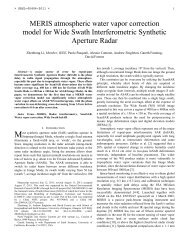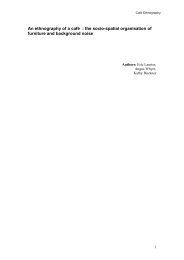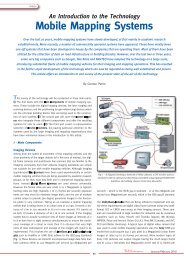Houdini and the wonder of
Houdini and the wonder of
Houdini and the wonder of
Create successful ePaper yourself
Turn your PDF publications into a flip-book with our unique Google optimized e-Paper software.
Ethnomethodology urges that its practitioners should notice what is unseen because it<br />
is so obvious. A note <strong>of</strong> caution here, <strong>Houdini</strong> deliberately hides what he is really up<br />
to, <strong>and</strong> <strong>the</strong> danger is that when we notice something ‘hidden’ in everyday life it<br />
entails an intentional agent, similar to a <strong>Houdini</strong>, that hides things by pulling <strong>the</strong><br />
wool over our eyes 5 . This is where ethnomethodology, in alerting us to un-noticed<br />
orderly features <strong>of</strong> social action, to our ‘trust in appearances’, might be misunderstood<br />
as revealing member’s ignorance <strong>of</strong> a massive con trick, whereas its concerns are that<br />
<strong>the</strong> massively orderly nature <strong>of</strong> our lives goes un-noticed <strong>and</strong> how it is that<br />
trustworthy appearances are routinely recognised <strong>and</strong> produced. Ethnomethdology<br />
proposes that we might be amazed by what we are doing in our everyday lives, ra<strong>the</strong>r<br />
than suspicious that if it is so organized <strong>the</strong>n surely a spirit <strong>of</strong> <strong>the</strong> age, a form <strong>of</strong><br />
capitalism, a genetic blueprint or a shared neural pattern must have done <strong>the</strong><br />
organizing. That participants in a conversation can take turns at talking <strong>and</strong> so rapidly,<br />
economically, intelligibly is awe-inspiring for Sacks (1992). That players <strong>of</strong> tic-tactoe<br />
cannot be stopped in <strong>the</strong>ir reasoning despite <strong>the</strong> greatest possible noncompliance<br />
with <strong>the</strong> game by <strong>the</strong>ir opponent amazes Garfinkel (ref).<br />
Part <strong>of</strong> our natural attitude to <strong>the</strong> world is that we trust in its appearances <strong>and</strong> it is so<br />
ordinary, so humble, <strong>and</strong> so utterly obvious that we fail to see it (Schutz 1973). There<br />
are occasions when we reflect on what happens, for instance, when we trip up <strong>and</strong> <strong>the</strong><br />
smooth flow <strong>of</strong> our conduct is interrupted, when we visit a foreign country, when we<br />
follow <strong>the</strong> joke made by Seinfeld 6 doing ‘observational comedy, or, when we take up<br />
pr<strong>of</strong>essional studies <strong>of</strong> human matters (<strong>of</strong> <strong>the</strong>orising, business, science, design, law,<br />
medicine). Are our everyday occasioned reflection on our practices, <strong>and</strong><br />
ethnomethodology’s more rigorous investigations, so far from <strong>Houdini</strong>’s request for<br />
an audience to look closely at him <strong>and</strong> his spectacular bonds, his cells, his cuffs or his<br />
straitjackets? Already we may be able to guess that <strong>the</strong>re are some reversals at work<br />
here that may reveal fur<strong>the</strong>r shared principles. From Garfinkel (1967) <strong>and</strong><br />
Wittgenstein (1953) we have <strong>the</strong> constant reminder : everything is in plain sight. The<br />
skill <strong>of</strong> <strong>the</strong> philosopher or ethnomethodologists is in revealing what is right before our<br />
eyes but we cannot see because we are blinded by its obviousness. From <strong>Houdini</strong>: we<br />
cannot see how he actually does what he does because we are blinded by <strong>the</strong> spectacle<br />
he has assembled as part <strong>of</strong> what he does. Ethnomethodology is not saying that<br />
ordinary members are magicians, since <strong>the</strong> magician knows how, in detail, <strong>the</strong>ir trick<br />
works, <strong>the</strong>y can show us how it works <strong>and</strong> what it constitutes. The ordinary member<br />
is more or less uninterested in how <strong>the</strong>y produce order, it is ethnomethodology that<br />
shows <strong>the</strong> methods that produce order. <strong>Houdini</strong>’s many escapades <strong>of</strong>fered a lesson not<br />
all that far from ethnomethodology’s raison d’etre, as Gibson writes in his<br />
introduction to his collection <strong>of</strong> <strong>Houdini</strong>’s works:<br />
In all, this book, with its abundance <strong>of</strong> <strong>Houdini</strong>’s own writings, shows how clearly<br />
magic, as practised by <strong>Houdini</strong>, was <strong>and</strong> is explainable by one faculty only: that <strong>of</strong><br />
human accomplishment, pxv (Gibson 1953).<br />
5 Incidentally pulling hats down over <strong>the</strong> eyes <strong>of</strong> pedestrians during a robbery is a trick mention by<br />
<strong>Houdini</strong> (1953) in ‘The Right Way to Do Wrong’.<br />
6 A hugely popular US TV comedy show from <strong>the</strong> late 90s based on <strong>the</strong> principle <strong>of</strong> its characters<br />
doing nothing <strong>and</strong> obsessing on nothing much, or perhaps more accurately dwelling at great length on<br />
<strong>the</strong> obvious.<br />
6
















